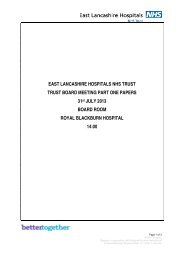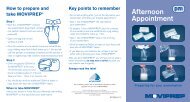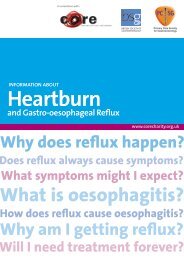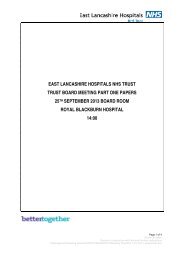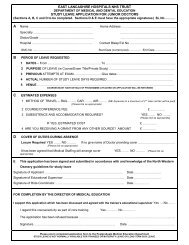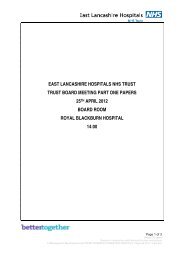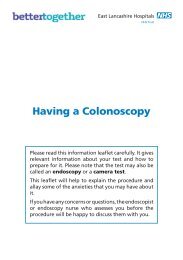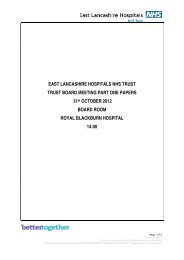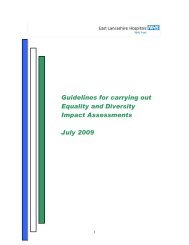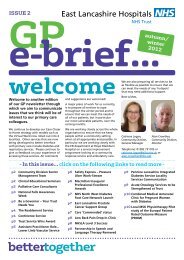(DOH) Uniform and Workwear - East Lancashire Hospitals NHS Trust
(DOH) Uniform and Workwear - East Lancashire Hospitals NHS Trust
(DOH) Uniform and Workwear - East Lancashire Hospitals NHS Trust
You also want an ePaper? Increase the reach of your titles
YUMPU automatically turns print PDFs into web optimized ePapers that Google loves.
Equality Impact Assessment<br />
<strong>Uniform</strong>s <strong>and</strong> <strong>Workwear</strong>: Guidance on uniform <strong>and</strong><br />
workwear policies for <strong>NHS</strong> employers<br />
Introduction<br />
1. Equality Impact Assessment (EqIA) is a tool aimed at improving the<br />
quality of local services by ensuring that local bodies systematically<br />
consider the actual or potential impacts of their policies <strong>and</strong> practices<br />
on certain communities <strong>and</strong> population groups. Organisations are<br />
required to take action to mitigate or eliminate the negative impacts<br />
<strong>and</strong> maximise the positive impacts or opportunities for promoting<br />
equality.<br />
Policy Aim<br />
2. This EqIA looks at the impact of the Department of Health's revised<br />
uniform <strong>and</strong> workwear guidance. The guidance is good practice<br />
guidance only. It aims to deliver to <strong>NHS</strong> employers an evidence base<br />
(<strong>and</strong> examples of good <strong>and</strong> poor practice), to allow the development of<br />
local policy on the wearing <strong>and</strong> laundering of uniforms. This should<br />
lead to an improvement in public confidence that the <strong>NHS</strong> is taking the<br />
issue of infection control seriously. The guidance is not prescriptive,<br />
except in respect of wearing uniforms that encourage good h<strong>and</strong><br />
washing <strong>and</strong> do not include functionless items of clothing.<br />
Results of initial screening of <strong>Uniform</strong> & <strong>Workwear</strong><br />
Guidance<br />
Negative impact<br />
Age<br />
Gender<br />
Ethnicit<br />
y<br />
Disabili<br />
ty<br />
Religio<br />
n <strong>and</strong><br />
belief<br />
Sexual<br />
orientat<br />
ion<br />
Does the policy<br />
represent any<br />
problems or barriers<br />
to any community or<br />
group?<br />
Yes No No No No No<br />
1
Is any group of<br />
people excluded as a<br />
result of this policy?<br />
Does the policy<br />
worsen existing<br />
discrimination <strong>and</strong><br />
inequality?<br />
Does the policy have<br />
a negative effect on<br />
community relations?<br />
Positive impact<br />
No No No No No No<br />
No No No No No No<br />
No No No No No No<br />
Age<br />
Gender<br />
Ethnicit<br />
y<br />
Disabili<br />
ty<br />
Religio<br />
n <strong>and</strong><br />
belief<br />
Sexual<br />
orientat<br />
ion<br />
Does the policy have<br />
a significant positive<br />
impact on equality by<br />
promoting equality of<br />
opportunity?<br />
Does the policy have<br />
a significant positive<br />
impact on equality by<br />
eliminating<br />
discrimination?<br />
Does the policy have<br />
a significant positive<br />
impact on equality by<br />
eliminating<br />
harassment?<br />
Does the policy have<br />
a significant positive<br />
impact on equality by<br />
promoting good<br />
community relations?<br />
Does the policy have<br />
a significant positive<br />
impact on equality by<br />
promoting positive<br />
attitudes towards<br />
disabled people?<br />
Does the policy have<br />
a significant positive<br />
No No No No Yes No<br />
No No No No No No<br />
No No No No No No<br />
No No No No Yes No<br />
No No No No No No<br />
No No No No No No<br />
2
impact on equality by<br />
encouraging the<br />
participation of<br />
disabled people?<br />
Does the policy have<br />
a significant positive<br />
impact on equality by<br />
considering more<br />
favourable treatment<br />
of disabled people?<br />
Does the policy have<br />
a significant positive<br />
impact on equality by<br />
promoting human<br />
rights?<br />
No No No No No No<br />
No No No No No No<br />
The evidence<br />
3. The Department's original uniform <strong>and</strong> workwear guidance was<br />
published in September 2007. On reviewing the equality screening (in<br />
December 2007 <strong>and</strong> March 2010), we reconsidered the impact of the<br />
guidance in respect of disability, age, gender <strong>and</strong> sexual orientation. As<br />
the guidance simply identifies good practice <strong>and</strong> does not offer specific<br />
rules beyond wearing uniforms that encourage <strong>and</strong> support effective<br />
h<strong>and</strong> hygiene <strong>and</strong> h<strong>and</strong>-washing we feel that the policy had a neutral<br />
impact in respect of disability, ethnicity, gender <strong>and</strong> sexual orientation.<br />
There seemed to be a possible issue in relation to age, as older people<br />
may prefer to dress more formally. The guidance should help trusts<br />
make informed decisions on such areas, although final resolutions will<br />
still be made locally.<br />
4. It is recognised that some uniforms are in apparent conflict with the<br />
dress codes of specific religions or cultures (eg head coverings,<br />
jewellery, long sleeves etc). In particular, there is evidence that<br />
adopting 'bare below the elbows' has presented difficulties for some<br />
Muslim female healthcare workers <strong>and</strong> students. Indeed, it has been<br />
reported that some staff had had such difficulty with those dress code<br />
provisions as to find that they could no longer continue in their jobs.<br />
5. The Department therefore worked jointly with the Muslim Spiritual Care<br />
Provision in the <strong>NHS</strong> (MSCP*) to consider these concerns. The<br />
outcome is that the guidance contains examples of how local dress<br />
code policies might be further developed such that individuals are able<br />
to align religious <strong>and</strong> cultural obligations with infection control<br />
responsibilities without compromising patient safety. We take the view<br />
that it is likely to provide a significant positive impact on equality by<br />
3
promoting equality of opportunity <strong>and</strong> by extension, on promoting<br />
good community relations.<br />
*The Muslim Spiritual Care Provision in the <strong>NHS</strong>, hosted by the Muslim Council of Britain in<br />
partnership with the Department of Health , is a resource <strong>and</strong> contributing in recruiting, training<br />
<strong>and</strong> empowering Muslim Chaplains in the health service.<br />
Based on the information set out above I have decided that an equality<br />
impact assessment is necessary.<br />
Signed: Dr Elizabeth Jones<br />
Business area: CNO-D Date: 12th March 2010<br />
4
UTitle <strong>and</strong> description of the policy<br />
6. The uniform <strong>and</strong> workwear guidance is a collection of evidence to help<br />
trusts devise their own local policies on laundering <strong>and</strong> wearing<br />
uniforms <strong>and</strong> on other aspects of a dress code. The guidance remains<br />
an exact fit with the requirements of the Health <strong>and</strong> Social Care Act<br />
2008 Code of Practice for the prevention <strong>and</strong> control of infections. The<br />
Code charges trusts with establishing uniform <strong>and</strong> dress code policies<br />
that specifically support good h<strong>and</strong> hygiene. The Department's Clean<br />
Safe Care strategy has demonstrated that effective screening, sensible<br />
prescribing, high st<strong>and</strong>ards of cleanliness <strong>and</strong> effectiveU h<strong>and</strong> hygieneU<br />
are all vitally important in the fight against infection<br />
UThe Evidence Base<br />
7. The publication of revised uniform <strong>and</strong> workwear guidance does not<br />
involve the development of new national policies – instead it continues<br />
to support trusts in the development of their own policies. We have<br />
tried, where possible, to keep the guidance evidence-based <strong>and</strong> flexible<br />
to allow for local implementation. This allows trusts to include specific<br />
equality issues within their own policy, as relevant to their community.<br />
8. In producing the original guidance, we commissioned two systematic<br />
literature reviews to examine:<br />
• The evidence around uniforms <strong>and</strong> workwear as a possible<br />
source of infection, <strong>and</strong> around the antimicrobial effect of<br />
laundry processes.<br />
• the importance attached by patients, staff <strong>and</strong> the public, to the<br />
concept of uniforms in healthcare.<br />
9. This has now been published (as two separate reviews) in peerreviewed<br />
journals as referenced below.<br />
• J.A. Wilson, H.P. Loveday, P.N. Hoffman, R.J. Pratt, <strong>Uniform</strong>: an<br />
evidence review of the microbiological significance of uniforms<br />
<strong>and</strong> uniform policy in the prevention <strong>and</strong> control of healthcareassociated<br />
infections. Report to the Department of Health<br />
(Engl<strong>and</strong>). Journal of Hospital Infection (2007) 66, 301e307<br />
5
• HP Loveday, JA Wilson, PN Hoffman, RJ Pratt; Public perception<br />
<strong>and</strong> the social <strong>and</strong> microbiological significance of uniforms in the<br />
prevention <strong>and</strong> control of healthcare-associated infections: an<br />
evidence review. British Journal of Infection Control. September<br />
2007 Vol. 8 No. 4<br />
10. We are satisfied that no further evidence has since emerged to<br />
challenge the findings in these reports.<br />
11. We have also established that the findings of the empirical research<br />
that was commissioned in 2007, to study the effects of various wash<br />
temperatures on removal of micro-organisms from uniform fabric,<br />
remains valid<br />
12. We have consulted <strong>NHS</strong> Employers to ensure that no new evidence<br />
has come to light that conflicts with any of the previous<br />
recommendations<br />
UWhat the evidence shows<br />
UDisability, gender, race, sexual orientation<br />
13. As indicated previously, we feel that the policy has a neutral impact in<br />
respect of disability, ethnicity, gender <strong>and</strong> sexual orientation. It is not<br />
considered that any further information is needed. The literature<br />
reviews <strong>and</strong> the advice of <strong>NHS</strong> employers' expert reference group are<br />
sufficient. <strong>NHS</strong> Employers provides specific guidance via its website<br />
<strong>and</strong> this is available to trusts.<br />
UAge<br />
14. On reviewing the policy of ' no tie, it remains possible that there is a<br />
differential impact on older members of staff if there is truth in the<br />
assertion that older people dress more formally. We feel that there is<br />
no need to revise the guidance as this is an issue that can be h<strong>and</strong>led<br />
locally.<br />
UReligion <strong>and</strong> belief.<br />
15. We remain satisfied that there are issues of hygiene (including h<strong>and</strong><br />
washing) <strong>and</strong> public expectation (eg the role of uniforms in enhancing<br />
public confidence) that have implications for uniforms in respect of<br />
religion <strong>and</strong> belief<br />
16. There is evidence that wearing of h<strong>and</strong> or wrist jewellery compromises<br />
the undertaking of effective h<strong>and</strong> hygiene. The guidance therefore<br />
6
makes it clear that it is poor practice to wear any jewellery, including a<br />
wristwatch, on the h<strong>and</strong>s or wrists during direct patient care activity.<br />
However, the Department is aware that there will be instances where,<br />
for religious reasons, members of staff may wish to wear a bracelet<br />
(for example the Sikh Kara) when they are not engaged in direct<br />
patient care activities. The guidance recognises that in these<br />
circumstances it is good practice to ensure such bracelets can be<br />
pushed up the arm <strong>and</strong> secured in place for h<strong>and</strong> washing <strong>and</strong> direct<br />
patient care activity. These references have been shared with<br />
organisations representing Hindu <strong>and</strong> Sikh interests <strong>and</strong> no objections<br />
have been raised.<br />
17. There is good evidence, from the previously referenced systematic<br />
literature reviews, that effective h<strong>and</strong> hygiene reduces the risk of<br />
infection, <strong>and</strong> wearing long sleeved clothes compromises its<br />
achievement.<br />
18. Whilst the phrase 'bare below the elbows' never appeared in the<br />
Department's original 2007 uniform <strong>and</strong> workwear guidance, it is the<br />
tag line by which it has become known. The Department has become<br />
aware that in certain cases, where trusts have adopted dress codes<br />
that literally require staff to be 'bare below the elbows' at all times, it<br />
has presented difficulties for a minority of Muslim female healthcare<br />
workers <strong>and</strong> students.<br />
19. It is acknowledged that the majority of <strong>NHS</strong> trusts have been able to<br />
use the original guidance to devise policies that take account of local<br />
factors without conflicting with religious requirements <strong>and</strong> for the<br />
majority of staff, being bare below the elbows during direct patient<br />
care activity has not presented any significant difficulty. However, in<br />
some cases, the local interpretation of what constitutes 'direct patient<br />
care activities' has caused some problems.<br />
20. The Department worked jointly with the Muslim Spiritual Care Provision<br />
in the <strong>NHS</strong> to address some of the concerns expressed by female<br />
Muslim healthcare workers <strong>and</strong> students. The result has been a<br />
revision to the existing guidance to address the issues around the<br />
practical aspects of implementing a dress code. This is achieved in part<br />
by providing a specimen definition of, <strong>and</strong> clarity of terms used in<br />
relation to, 'direct patient care activity'. This should help by more<br />
clearly defining the precise areas where staff should observe dress<br />
codes when performing patient care duties involving direct patient<br />
contact or within the patient's close environment.<br />
21. The revised guidance also now identifies some adaptations to local<br />
dress codes that might be adopted to ensure they are more sensitive<br />
to the requirements of different religious groups <strong>and</strong> that can be<br />
accommodated without compromising patient safety or staff dignity.<br />
7
22. The guidance recognises that a very small number of staff have<br />
expressed the view that for them the strong preference is to use<br />
disposable over-sleeves to cover forearms during direct patient care<br />
activity. The guidance therefore recognises that such over sleeves can<br />
be worn where gloves are used. It cautions that strict adherence to<br />
washing h<strong>and</strong>s <strong>and</strong> wrists must be observed before <strong>and</strong> after use <strong>and</strong><br />
that over-sleeves must be discarded in exactly the same way as<br />
disposable gloves.<br />
23. The guidance also makes it clear that decisions on the adoption of any<br />
of the measures outlined should be taken in conjunction with clinical<br />
managers <strong>and</strong> the infection prevention <strong>and</strong> control team <strong>and</strong> form part<br />
of the trust's policies.<br />
Challenges <strong>and</strong> opportunities<br />
24. The MSCP reported that some Muslim female staff had been so<br />
negatively affected by 'bare below the elbows' dress codes as to find<br />
they could no longer continue in their current roles, This has caused<br />
disquiet among Muslim female healthcare workers, medical students<br />
<strong>and</strong> trainees.<br />
25. We consider that the provision of further guidance for trusts about<br />
practical steps that can be taken to ensure patient safety without<br />
compromising religious or cultural beliefs is a very positive step. We<br />
also consider that the local consideration, approval <strong>and</strong> adoption of<br />
such practical steps can have a beneficial effect on recruitment. We are<br />
satisfied that this can be achieved without compromising the principles<br />
of ensuring that uniform <strong>and</strong> dress codes should support good h<strong>and</strong><br />
hygiene.<br />
Equality Impact Assessment<br />
26. A negative impact is unlikely <strong>and</strong> we believe the risk of adverse effect<br />
is small. The guidance has been kept deliberately flexible <strong>and</strong> evidence<br />
based that <strong>NHS</strong> trusts can develop their own policies to take account of<br />
local circumstances.<br />
27. On reviewing the policy of 'no tie' it is possible that there is a<br />
differential impact on older members of staff - but only if there is truth<br />
in the assertion that older people prefer to dress more formally. We<br />
felt there was no reason to revise the guidance as this is an issue that<br />
can be h<strong>and</strong>led locally.<br />
28. The MSCP has identified a number of practical steps in relation to the<br />
guidance that trusts might take to ensure patient safety without<br />
8
compromising religious or cultural beliefs. We feel that the provision of<br />
this statement means that the potential for a differential impact on<br />
members of particular religious groups has been removed.<br />
29. We recognise that elements of the additional guidance could be seen<br />
to be introducing differing requirements for those to whom 'baring<br />
below the elbows' presents no significant problem. We have considered<br />
the implications of this possibility but concluded that the overall<br />
purpose of the guidance, to ensure patient safety by adherence to<br />
good h<strong>and</strong> hygiene, is not prejudiced by the additional dress options<br />
that have now been identified.<br />
30. The guidance has the clear potential to have a positive effect. This is<br />
by firstly having a significant positive impact on promoting equality of<br />
opportunity, <strong>and</strong> secondly, by promoting good community relations.<br />
Next steps<br />
31. The available evidence continues to suggest that patients <strong>and</strong> the<br />
public use the personal appearance of staff as a way of judging<br />
competence - both in respect of the individual <strong>and</strong> in terms of the <strong>NHS</strong><br />
as a whole.<br />
32. There is little evidence that uniforms are a significant source of<br />
infection, but the belief persists amongst the public that they are.<br />
There is clear evidence that h<strong>and</strong> hygiene is compromised by h<strong>and</strong> <strong>and</strong><br />
wrist jewellery, <strong>and</strong> by clothing that prevents the wrist being included<br />
in h<strong>and</strong> hygiene. There is also evidence that cuffs become heavily<br />
contaminated.<br />
33. The Health Act 2008 Code of Practice for the prevention <strong>and</strong> control of<br />
infections includes a requirement that trusts should have local uniform<br />
<strong>and</strong> dress codes polices in place that specifically support good h<strong>and</strong><br />
hygiene. The Care Quality Commission assesses providers against their<br />
compliance with this provision. The outcome of those assessments<br />
becomes a matter of public record <strong>and</strong> has a definite impact on the<br />
public's confidence that trusts are taking infection control seriously.<br />
34. We are confident that this issue is of sufficient importance to need<br />
central good practice guidance. It will be for trusts to define their own<br />
local policies.<br />
9



